Sir John Monash, Personal Files Book 6, 10 June - 12 July 1915, Part 8
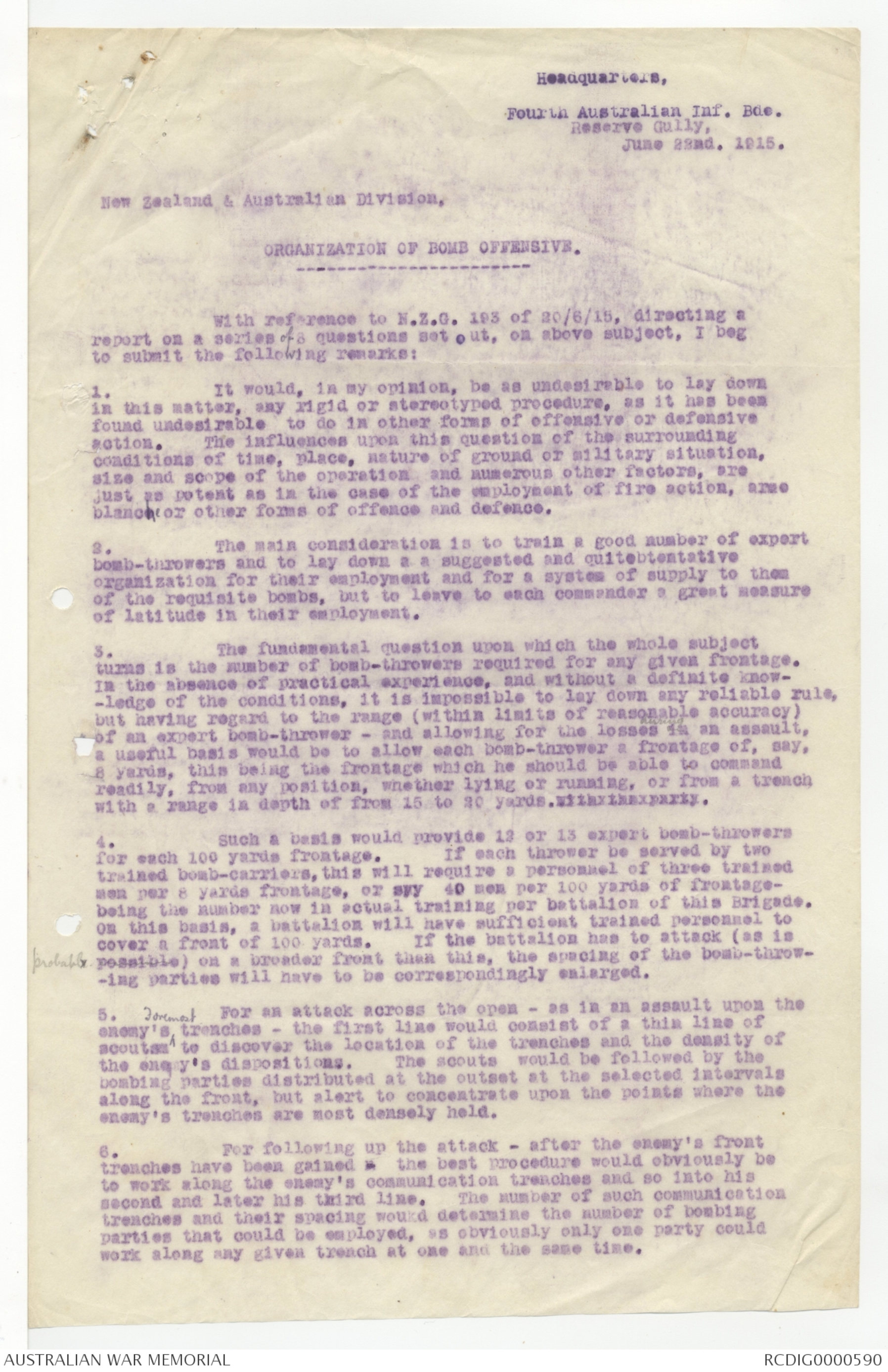
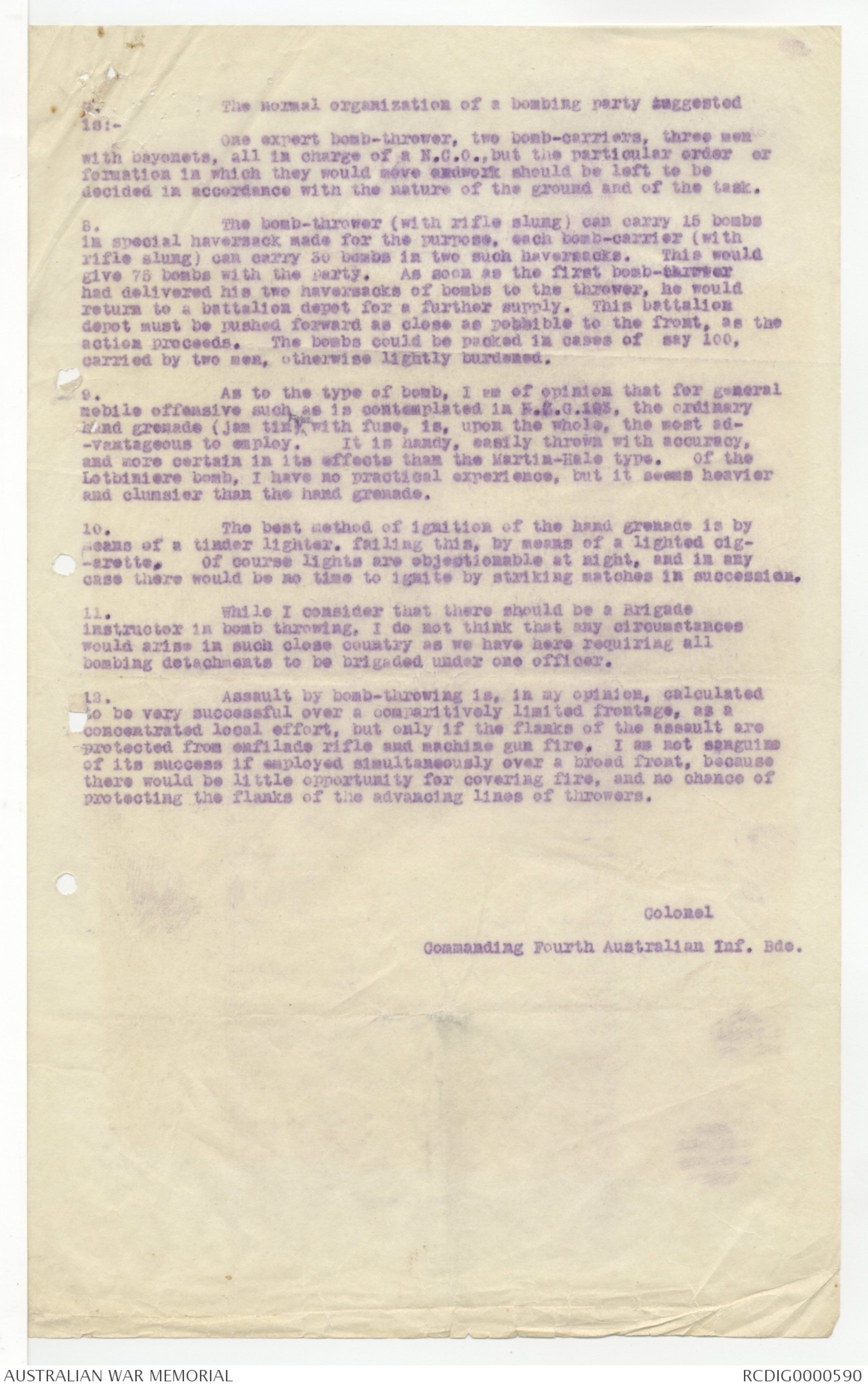
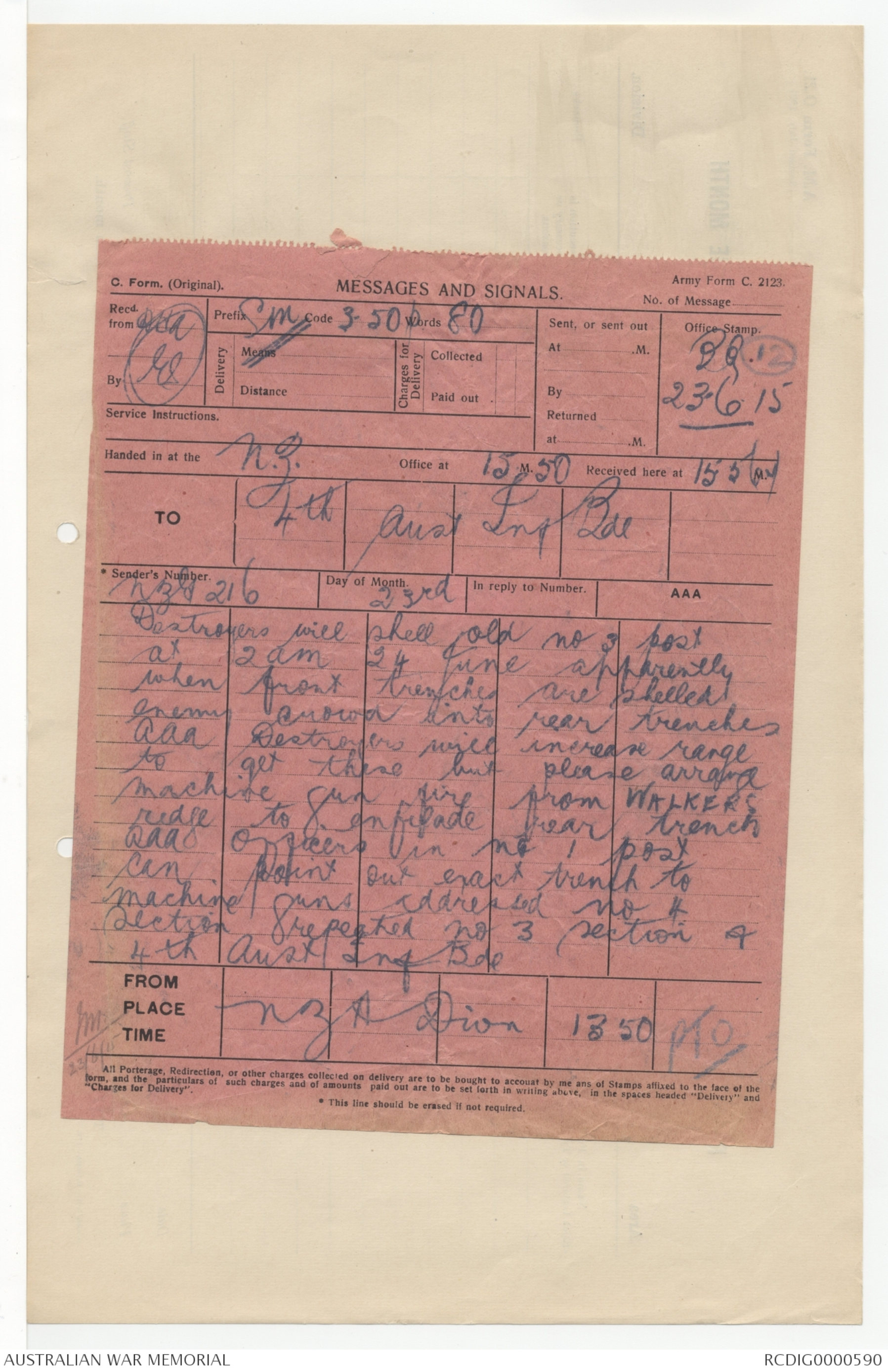
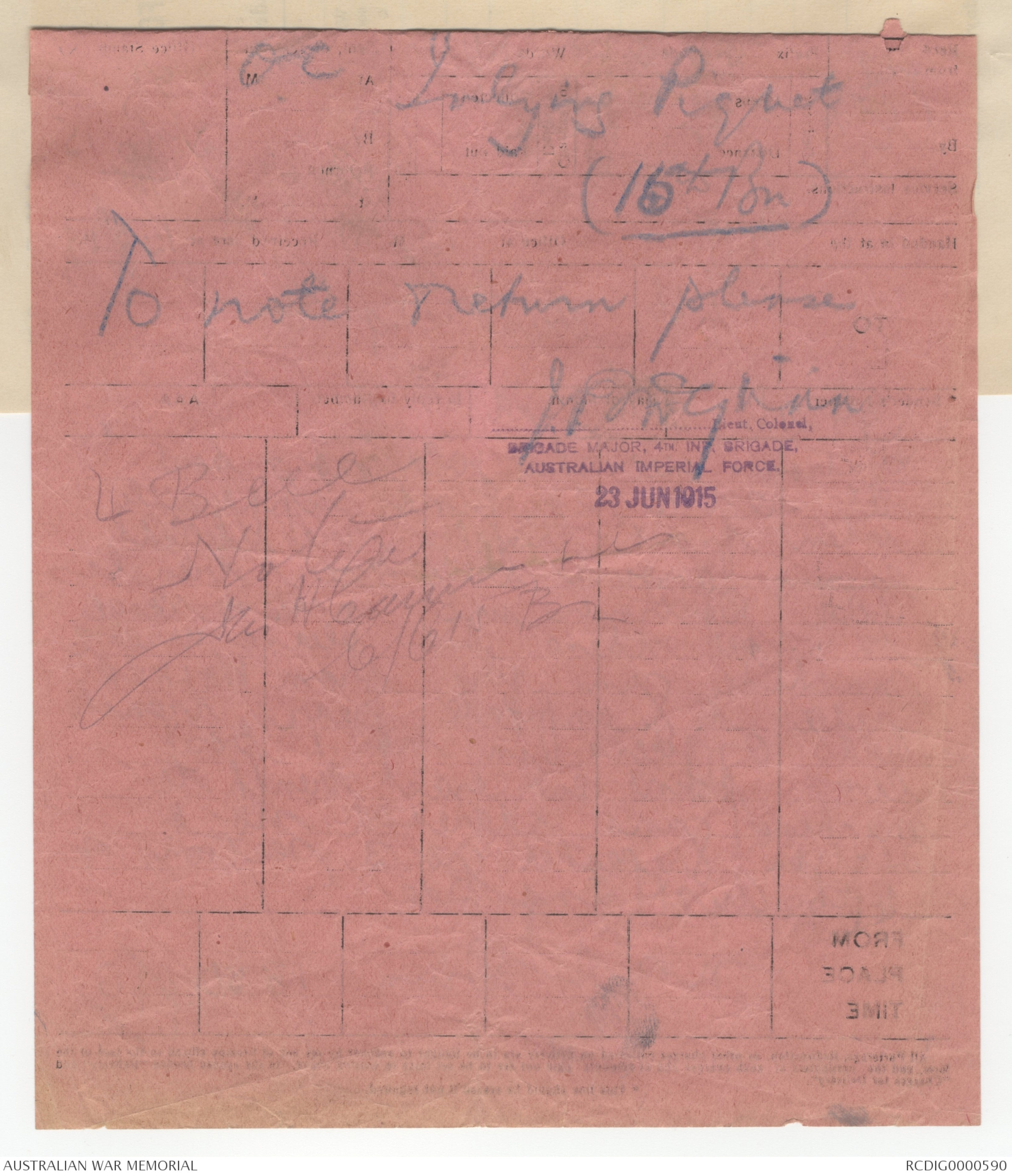
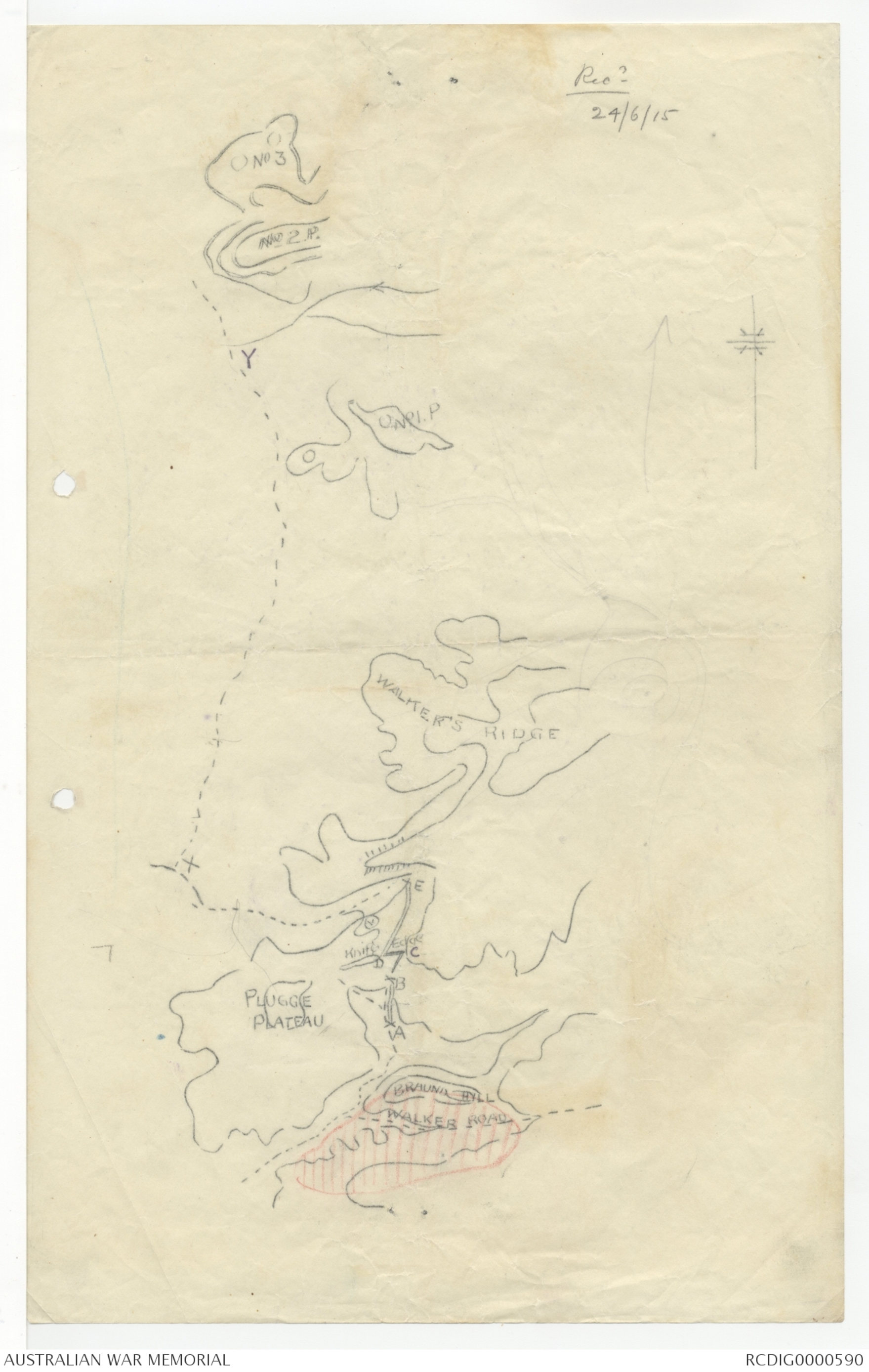
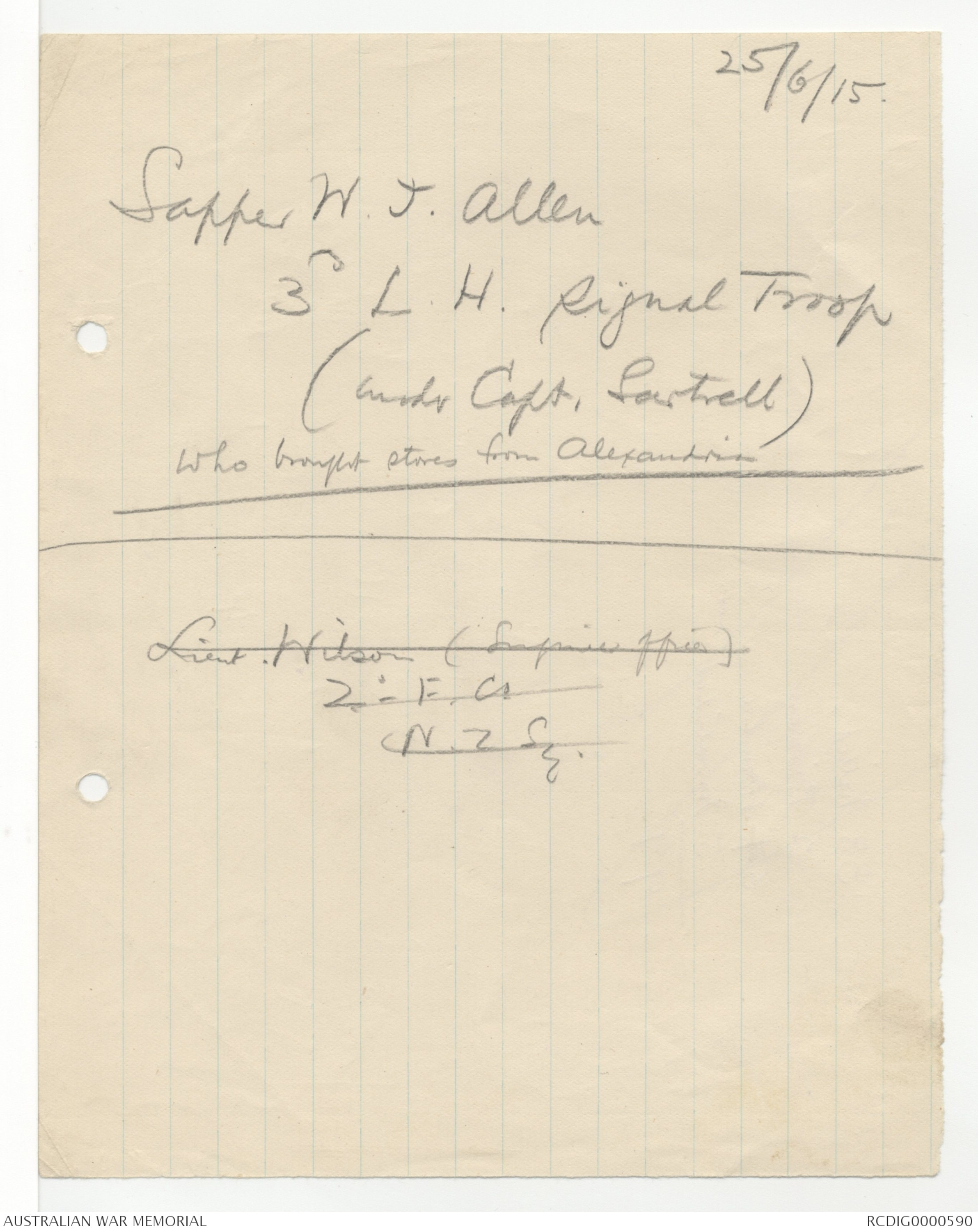
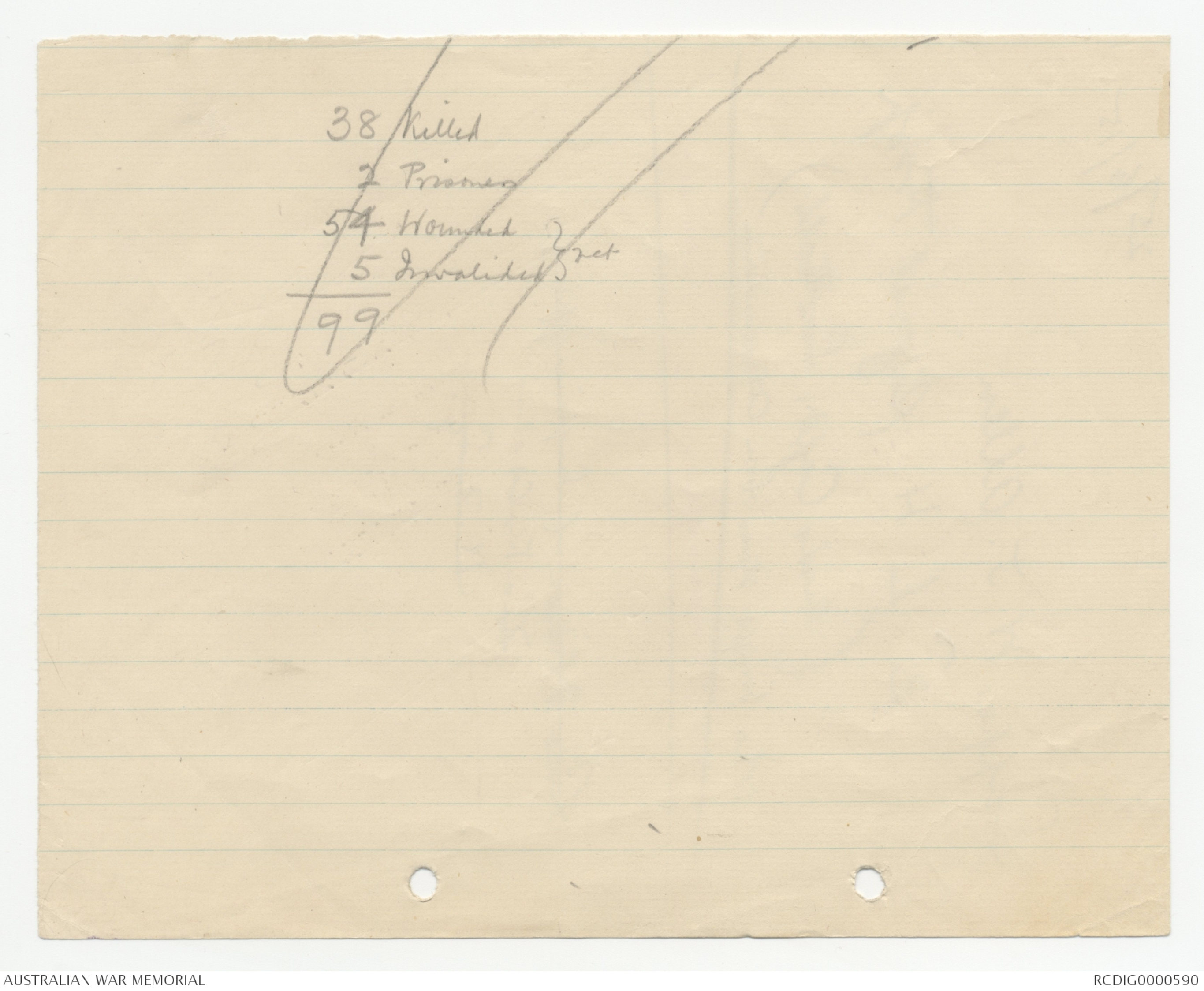
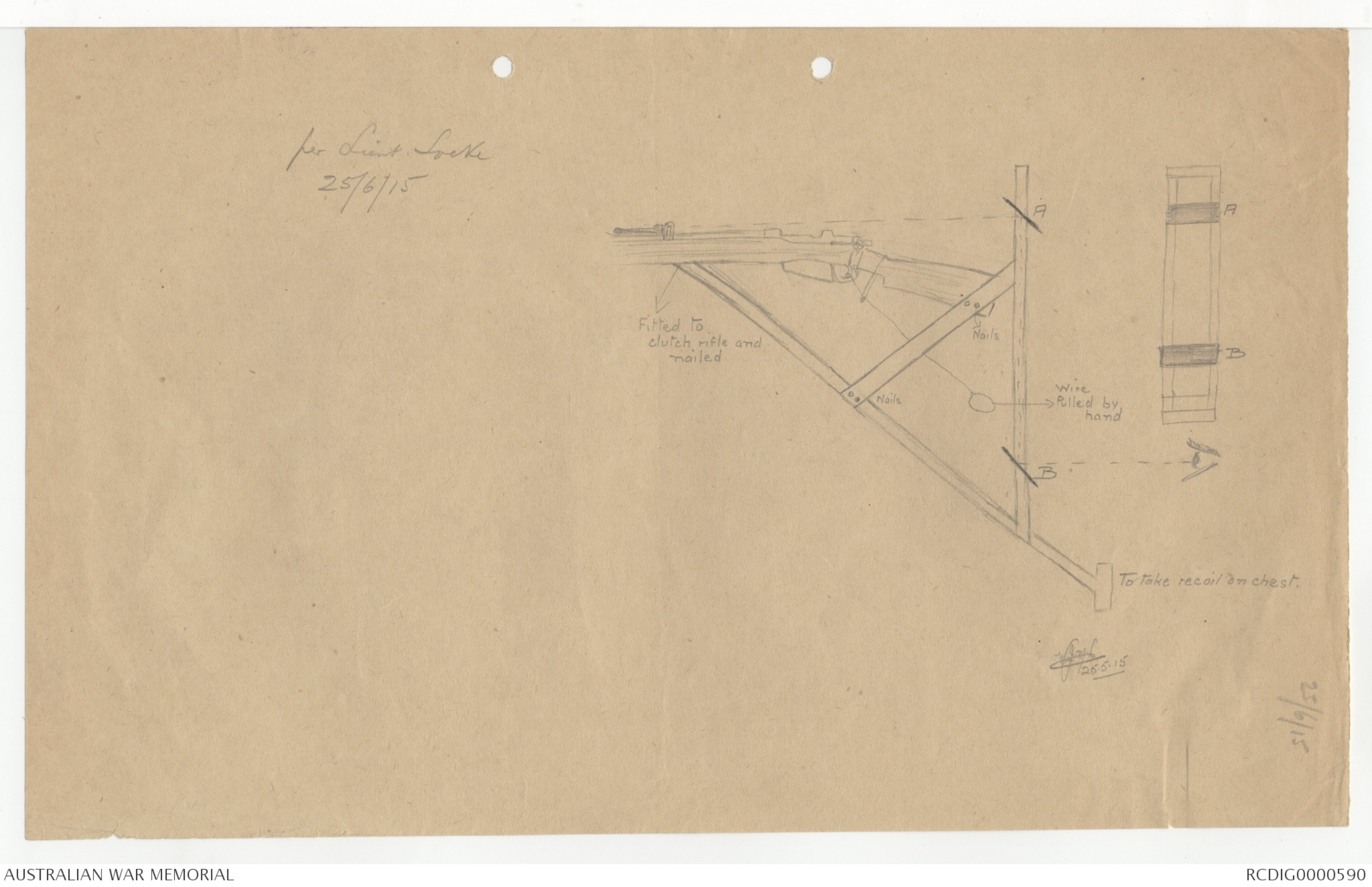
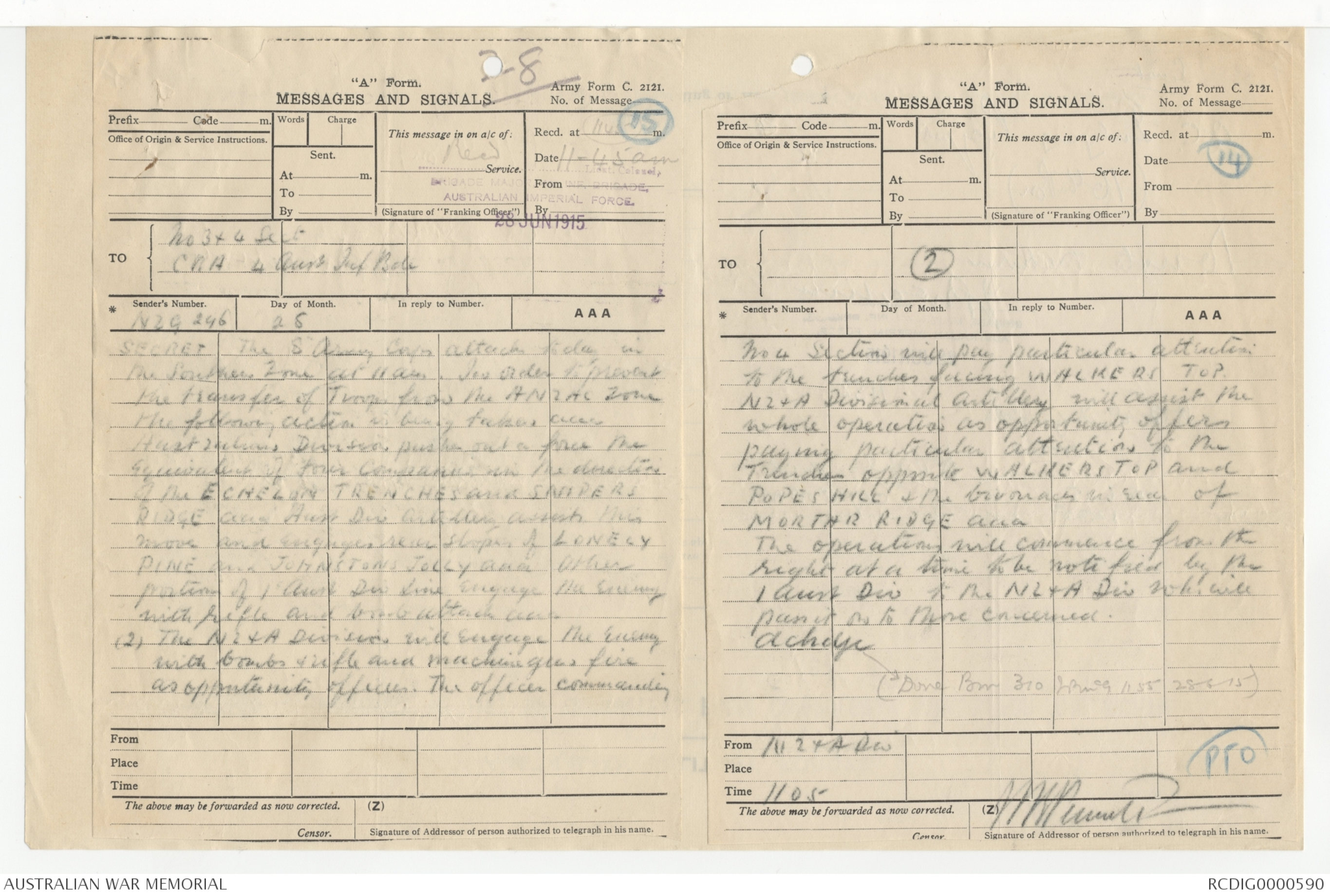
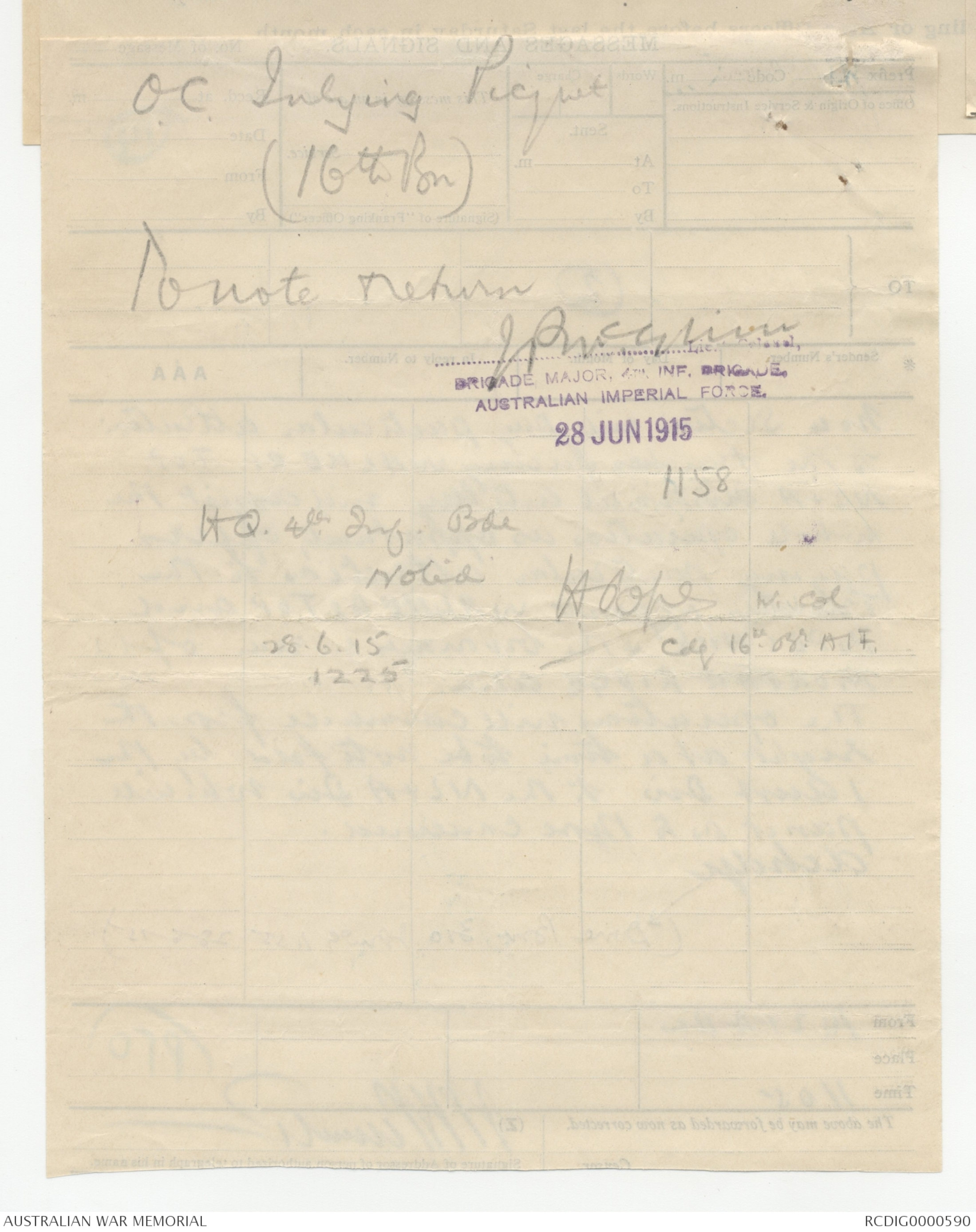
Headquarters,
Fourth Australian Inf. Bde.
Reserve Gully,
June 22nd, 1915.
New Zealand & Australian Division,
ORGANIZATION OF BOMB OFFENSIVE.
With reference to N.Z.G. 193 of 20/6/15, directing a
report on a series of 8 questions set out, on above subject, I beg
to submit the following remarks:
1. It would, in my opinion, be as undesirable to lay down
in this matter, any rigid or stereotyped procedure, as it has been
found undesirable to do in other forms of offensive or defensive
action. The influences upon this question of the surrounding
conditions of time, place, nature of ground or military situation,
size and scope of the operation and numerous other factors, are
just as potent as in the case of the employment of fire action, arme
blanche or other forms of offence and defence.
2. The main consideration is to train a good number of expert
bomb-throwers and to lay down a suggested and quite tentative
organization for their employment and for a system of supply to them
of the requisite bombs, but to leave to each commander a great measure
of latitude in their employment.
3. The fundamental question upon which the whole subject
turns is the number of bomb-throwers required for any given frontage.
In the absence of practical experience, and without a definite knowledge
of the conditions, it is impossible to lay down any reliable rule,
but having regard to the range (within limits of reasonable accuracy)
of an expert bomb-thrower - and allowing for the losses ^during in an assault,
a useful basis would be to allow each bomb-thrower a frontage of, say,
8 yards, this being the frontage which he should be able to command
readily, from any position, whether lying or running, or from a trench
with a range in depth of from 15 to 20 yards. xxxxxxxxx
4. Such a basis would provide 12 or 13 expert bomb-throwers
for each 100 yards frontage. If each thrower be served by two
trained bomb-carriers, this will require a personnel of three trained
men per 8 yards frontage, or say 40 men per 100 yards of frontage -
being the number now in actual training per battalion of this Brigade.
On this basis, a battalion will have sufficient trained personnel to
cover a front of 100 yards. If the battalion has to attack (as ispossible∧probable) on a broader front than this, the spacing of the bomb -
throwing parties will have to be correspondingly enlarged.
5. For an attack across the open - as in an assault upon the
enemy's ^ Foremost trenches - the first line would consist of a thin line of
scouts to discover the location of the trenches and the density of
the enemy's dispositions. The scouts would be followed by the
bombing parties distributed at the outset at the selected intervals
along the front, but alert to concentrate upon the points where the
enemy's trenches are most densely held.
6. For following up the attack - after the enemy's front
trenches have been gained x the best procedure would obviously be
to work along the enemy's communication trenches and so into his
second and later his third line. The number of such communication
trenches and their spacing would determine the number of bombing
parties that could be employed, as obviously only one party could
work along any given trench at one and the same time.
7. The normal organization of a bombing party suggested
is: -
One expert bomb-thrower, two bomb-carriers, three men
with bayonets, all in charge of a N.C.O., but the particular order or
formation in which they would move should be left to be
decided in accordance with the nature of the ground and of the task.
8. The bomb-thrower (with rifle slung) can carry 15 bombs
in special haversack made for the purpose, each bomb-carrier (with
rifle slung) can carry 30 bombs in two such haversacks. This would
give 75 bombs with the party. As soon as the first bomb-thrower
had delivered his two haversacks of bombs to the thrower, he would
return to a battalion depot for a further supply. This battalion
depot must be pushed forward as close as possible to the front, as the
action proceeds. The bombs could be packed in cases of say 100,
carried by two men, otherwise lightly burdened.
9. As to the type of bomb, I am of opinion that for general
mobile offensive such as is contemplated in N.Z.G.193, the ordinary
hand grenade (jam tin)∧type with fuse, is, upon the whole, the most advantageous to employ. It is handy, easily thrown with accuracy,
and more certain in its effects than the Martin-Hale type. Of the
Letbiniere bomb, I have no practical experience, but it seems heavier
and clumsier than the hand grenade.
10. The best method of ignition of the hand grenade is by
means of a tinder lighter. Failing this, by means of a lighted cigarette.
Of course lights are objectionable at night, and in any
case there would be no time to ignite by striking matches in succession.
11. While I consider that there should be a Brigade
instructor in bomb throwing, I do not think that any circumstances
would arise in such close country as we have here requiring all
bombing detachments to be brigaded under one officer.
12. Assault by bomb-throwing is, in my opinion, calculated
to be very successful over a comparatively limited frontage, as a
concentrated local effort, but only if the flanks of the assault are
protected from enfilade rifle and machine gun fire. I am not sanguine
of its success if employed simultaneously over a broad front, because
there would be little opportunity for covering fire, and no chance of
protecting the flanks of the advancing lines of throwers.
Colonel
Commanding Fourth Australian Inf. Bde.
Army Form C.2123.
C. Form. (Original).
MESSAGES AND SIGNALS.
No. of Message ...
Recd. from QHA
By ES
Prefix SM
Code 3.50p
Words 80
Delivery
Means
Distance
Charges for Delivery
Collected
Paid out
Sent, or sent out
At ... M.
By ...
Returned ...
at ... M.
Office stamp
BQ 12
12
23.6.15
Service Instructions.
Handed in at the N.Z. Office at 15M. 50 Received here at 15.56 PM
TO 4th Aust Inf Bde
*Sender's Number. NZD 216
Day of Month. 23rd
In reply to Number.
AAA
Destroyers will shell old no 3 post
at 2 am 24 June apparently
when front trenches are shelled
enemy crowd into rear trenches
AAA Destroyers will increase range
to get these but please arrange
machine gun fire from WALKERS
ridge to enfilade rear trench
AAA Officers in no 1 post
can point out exact trench to
machine guns addressed no 4
Section repeated no 3 Section of
4th Aust Inf Bde
FROM NZA Divn
PLACE
TIME 1350
PTO
JM
23/6/15
All Porterage, Redirection, or other charges collected on delivery are to be brought to accouat by me ans of Stamps affixed to the face of the
form, and the particulars of such charges and of amounts paid out are to be set forth in writing above, in the spaces headed "Delivery" and
"Charges for Delivery".
* This line should be deleted if not required.
OC Inlying Piquet
(15th Bn)
To note return please
JP McGlinn Lieut, Colonel,
BRIGADE MAJOR, 4TH INF BRIGADE
AUSTRALIAN IMPERIAL FORCE
23 JUN 1915
4 Bde
Noted
Ja H Cannan Lt
C / G 15 Bn
Recd
24/6/15
25/6/15
Sapper W. J. Allen
3rd L.H. Signal Troop
(under Capt, Gartrell)
Who brought stores from Alexandria
Lieut. Wilson (Sapxxi office)2-F.CoN.Z.S
38 Killed2 Prisoners54 Wounded} [[net?]] 5 Invalided
99
For Lieut Locke
25/6/15
28
"A" Form
Army Form C 2121.
MESSAGES AND SIGNALS.
No. of Message.
Prefix ... Code ... m.
Words
Charge
Office of Origin & Service Instructions.
Sent
At ... m.
To
By
This message in on a/c of
Recd Service .
(Signature of "Franking Officer")
Recd. at 1145 m. 15
Date 11.45 am
From BRIGADE MAJOR 4TH INF BRIGADE
AUSTRALIAN IMPERIAL FORCE.
28 JUN 1915
TO } No 3 & 4 Sect
} CRA 4 Aust Inf Bde
Sender's Number.
NZG 246
Day of Month.
25
In reply to Number.
A A A
SECRET The 8th Army Corps attack today in
the Southern Zone at 11am. In order to prevent
the transfer of Troops from the ANZAC Zone
the following action is being taken aaa
Australian's Division pushes out a force the
equivalent of four companies in the direction
of the ECHELON TRENCHES and SNIPERS
RIDGE aaa Aust Div Artillery assists this
move and engages rear slopes of LONELY
PINE and JOHNSTONS JOLLY aaa Other
positions of 1 Aust Div line engage the enemy
with rifle and bomb attack aaa.
(2) The NZ & A Divisions will engage the enemy
with bombs & rifle and machine gun fire
as opportunity offers. The officer commanding
From
Place
Time
The above may be forwarded as now corrected
Censor
(Z)
Signature of Addressor of person authorized to telegraph in his name.
Date 14
TO 2
No 4 Sections will pay particular attention
to the trenches facing WALKERS TOP.
NZ & A Divisional Artillery will assist the
whole operation as opportunite offers
paying particular attention to the
trenches opposite WALKERS TOP and
POPES HILL & the bivouacs in each of
MORTAR RIDGE area
The operations will commence from the
right at a time to be notified by the
1 Aust Div to the NZ & A Div who will
pass it onto those concerned.
Acknge
(Done Bm 310 JP McG 1155 28-6-15)
From NZ & A Div
Place
Time 1105 PT0
J P McGlinn
Signature of person authorized to telegraph in his name.
OC Inlying Picquet
(16th Bn)
To note return
J P Mc Glinn
BRIGADE MAJOR 4TH INF. BRIGADE.
AUSTRALIAN IMPERIAL FORCE.
28 JUN 1915
1158
HQ. 4th Inf. Bde
Noted
H Pope W.Col
Cdg 16th Bn AIF.
28.6.15
1225
 Andrew Dobbin
Andrew DobbinThis transcription item is now locked to you for editing. To release the lock either Save your changes or Cancel.
This lock will be automatically released after 60 minutes of inactivity.